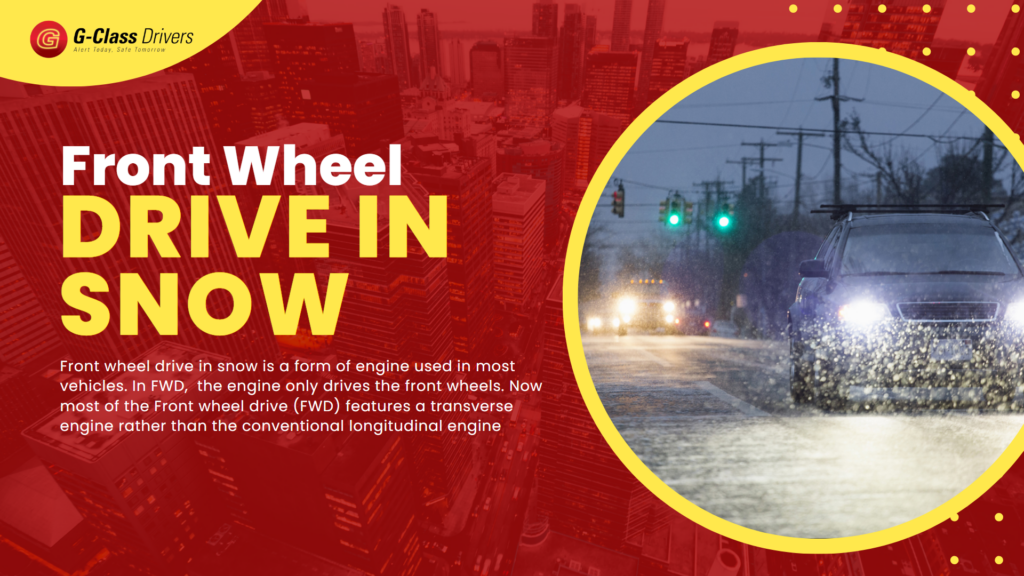Front wheel drive in snow allows cars to efficiently handle and adapt to the new surface. The primary question drivers ask is whether they need winter tires. The answer to this question is Yes. Even if the vehicle is AWD, FWD, RWD or four-wheel drive, winter tires are required in areas with freezing temperatures.
Driving in deep snow and ice is dangerous, so proper precautions must be taken. Most drivers who experience snowy conditions believe all-wheel drive (AWD) vehicles provide the optimal solution, but traction control relies heavily on tires suited for winter conditions; even the best AWD vehicles could struggle in these circumstances.
What is Front Wheel Drive In Snow?
Front wheel drive in snow is a form of engine used in most vehicles. In FWD, the engine only drives the front wheels. Now most of the Front wheel drive (FWD) features a transverse engine rather than the conventional longitudinal engine. The conventional longitudinal engine arrangement is generally found in rear-wheel-drive (RWD) and four-wheel-drive (4wd) systems. Front wheel drive in snow is better because it helps you move forward more quickly. But it can be harder to steer on a slippery surface. If you skid or try to turn, you might not be able to change direction easily.
Types of Wheel Drive in Snow
The four main types of wheel drive are as follows:
Front-wheel drive
When it comes to driving in snow Front-wheel drive is much better as it provides more traction. Due to this it’s easy to move through ice and snow. The weight of the vehicle is mostly on the front wheels due to which the car can move forward. But still it’s not best for severe blizzards or snowy conditions.
Rear-wheel Drive
Rear-wheel Drive can handle more torque but it’s not best for snowy conditions. The weight distribution of Rear-wheel vehicles causes them to slide sideways. Due to the lack of weight on rear tires it’s difficult to gain traction. Although you can drive with Rear-wheel Drive in snowy conditions, it’s better to avoid.
All-wheel Drive
All-wheel Drive is better in snowy conditions and as the name suggests the power is sent to all four wheels. Due to this it’s too cold to drive in snow and bad weather conditions. The AWD system adjusts to the conditions and can help you maintain traction. But the system cant provide any significant advantage when it comes to stopping or steering. But it’s best if you want to drive safely.
Four-wheel Drive
Four-wheel Drive is basically for big trucks. Four-wheel Drive assists in snowy conditions and helps maintain control on the car. But the issue is that these cars consume a lot of fuel. Although Four-wheel Drive is good for snowy conditions but its better to be extra cautious.
Benefits of Front Wheel Drive In Snow
Following are some of the benefits of Front Wheel Drive In Snow:
- Due to the engine’s weight on the front wheels, better traction is provided. This allows the driver to handle the vehicle better in snowy conditions.
- Front Wheel Drive vehicles are more affordable than AWD systems, making them a budget-friendly option.
- FWD vehicles have fewer mechanical components as compared to AWS vehicles.
- Front wheel drive vehicles are more efficient, lighter, and use less fuel.
- These vehicles are also easy to maintain due to fewer components.
Tips To Drive Front Wheel Drive In Snow
Winter driving can be dangerous, but with proper precautions and safety measures, you can easily drive in such circumstances. For Front Wheel Drive In Snow, the following tips will be helpful for you:
Dont Stop Your Car
While driving Front Wheel Drive In Snow, try to avoid applying brakes until necessary. This will allow you to use all your front wheel vehicle’s abilities. Unnecessary applying brakes can cause you to lose control of your vehicle. You can also lose traction on the thin sheet of ice.
Anticipate Upcoming Turns
When driving in snow, always look ahead to anticipate what’s coming. Pay attention to shiny or dull surfaces that might be dangerous. These include black ice, different types of snow, and water, which can affect your car’s traction. Front wheel drive cars work better when you are careful and watch the road. It’s important to drive carefully and anticipate any problems to stay safe. Try to take necessary precautions instead of being defensive in snowy conditions.
Refrain Oversteering
Driving in the snow, your car might slip on the surface. But do not panic if your car starts to drift, and stop oversteering your car. Instead of correcting your movement, let your car move with the snow. Slowly adjust your car movements, as steering too much can cause the car to slip in snowy situations. The front wheel drive works best if you let it work with the snow.
Avoid Jerky Movements
Another important point to consider while Front Wheel Drive in Snow is to avoid any jerky movements. If you steer too fast, jerky movements can happen, which will cause you to lose control of the vehicle. Try to anticipate the upcoming movements so that you can make turns accordingly. Although front wheel drive in snow is powerful, jerky movements can cause accidents, so try to avoid them.
Use Snow to Your Advantage
You can use the snow to your advantage when using Front Wheel Drive cars. For instance, if you have issues applying brakes or the brakes aren’t working properly, you can use the thick snow to slow the vehicle. Similarly, you can control your vehicle if you refrain from accelerating in thick snow. These tips can help you maintain your speed without damaging your front wheel drive car.
Avoid Driving In Blizzards
Although front wheel drive works best in snow, it generally applies to thin snow. These cars are unsuited for heavy blizzards or six feet of white ice. It’s better to avoid such conditions as these can lead to accidents.
Freeing a Stuck FWD Car in Snow
Front Wheel cars allow you to drive in snowy conditions, but there might still be conditions when your car gets stuck in snow. If your front-wheel-drive car gets stuck in snow, try these tips before getting help:
- Clear snow around the tires and press gently on the gas pedal. This will give some space for the car to move.
- If the wheels pause, turn off the traction control temporarily. This limits the powertrain output in low traction situations.
- Start in second gear if possible, as it will help the front wheel drive in the snow to rotate gently.
- Turn the wheel while pressing the gas to find a better grip.
- Rock the car gently between drive and reverse to build momentum. Go back and forth to gain more momentum.
Conclusion
To conclude, front wheel drive in snow cars can be reliable if equipped with suitable winter tires. This offers better traction and smoother handling. FWD vehicles are more budget-friendly and efficient compared to all-wheel-drive (AWD) systems. Precautions such as avoiding sudden movements, anticipating turns, and utilizing the snow’s resistance can enhance control.
However, drivers must remain extra careful, especially in challenging conditions, as FWD vehicles might not be suitable for heavy blizzards. If your car is stuck, strategic measures like clearing snow, adjusting the gas pedal, and gently rocking the car can provide a solution. However, by acknowledging the strengths and weaknesses of FWD in snow, drivers can maximize its benefits and ensure a safe journey in winter weather.





